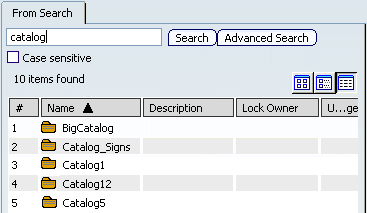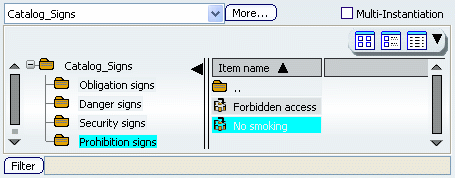Instantiating a 2D Component from a Catalog | |||
| |||
Select Tools > Catalog Browser
 from
the menu bar.
The Catalog Browser dialog box appears. (This dialog box
is described in the Catalog User's Guide.)
from
the menu bar.
The Catalog Browser dialog box appears. (This dialog box
is described in the Catalog User's Guide.)Click the More... button to search a catalog. The Object Selection dialog box appears. (This dialog box is described in the Catalog User's Guide.)
Type a name for your research, then click Search. The Object Selection dialog box displays the search result.

Select a catalog from the list then click OK to close the Object Selection dialog box. The Catalog Browser dialog box displays the catalog structure content.

Expand the catalog structure and select a chapter. The content of the chapter appears in the right window.
Important: You can choose to display the content using various formats from the top-right corner: thumbnails, tiles or details. Tip: If needed, check the Multi-Instantiation option, then proceed as described below (until step 9). To stop the multi-instantiation, select another command or press two times the Escape button. Double-click a 2D component from the list. You can also right-click the 2D Component and select Use Item > Instantiate 2D Component from the contextual menu.
Click the sheet (or the 2D layout) to position the 2D component instance. The Tools Palette toolbar appears.

Select one of the following commands:
-
Link with detail
 :
to instantiate a 2D component. The component instance is
linked with its external reference. Therefore, this instance
can be updated using Edit > Links & Relations... Synchronize
Link option.
By default, this icon is activated.
:
to instantiate a 2D component. The component instance is
linked with its external reference. Therefore, this instance
can be updated using Edit > Links & Relations... Synchronize
Link option.
By default, this icon is activated. -
Expose
 :
to instantiate and expose a 2D component. The links between
the 2D component instance and its reference in a catalog
are cut. However, a link with a new 2D component reference
(created from the catalog) is created on a detail sheet.
:
to instantiate and expose a 2D component. The links between
the 2D component instance and its reference in a catalog
are cut. However, a link with a new 2D component reference
(created from the catalog) is created on a detail sheet.
-
Click the sheet when you are satisfied with the component's position.
- If Link with detail
 is activated: The 2D component instance is created.
is activated: The 2D component instance is created. - If Expose
 is activated:
The Expose 2D Component Instance dialog box appears.
is activated:
The Expose 2D Component Instance dialog box appears.
- Define if you want to create the 2D component instance in a new detail sheet or in an existing detail sheet.
- Click OK. The 2D component instance is created.
- If Link with detail
Click Close in the Catalog Browser dialog box when you are done.